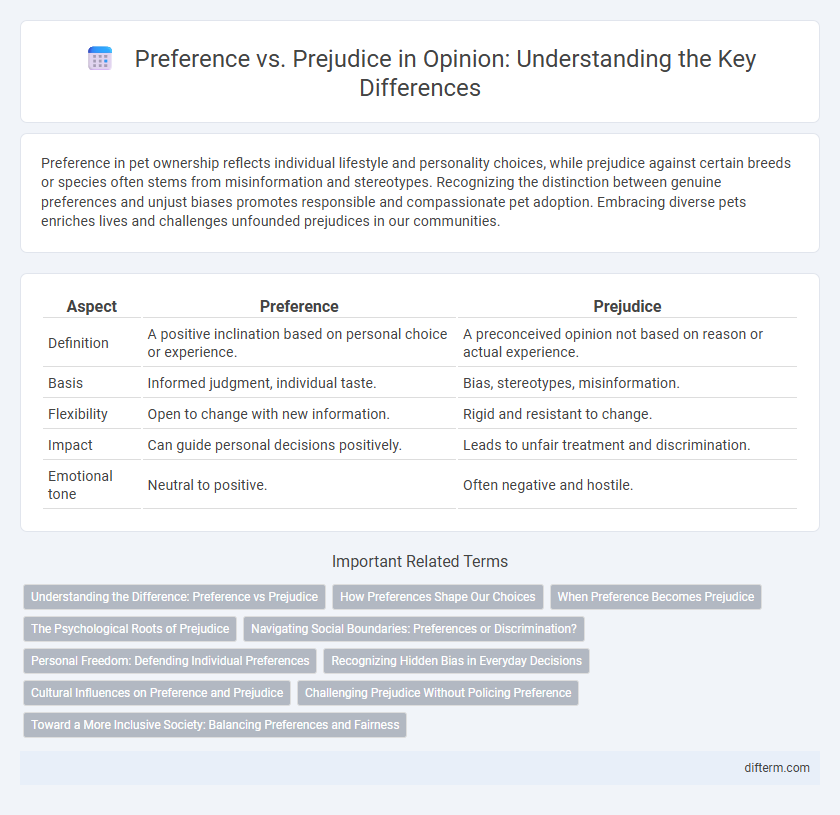Preference in pet ownership reflects individual lifestyle and personality choices, while prejudice against certain breeds or species often stems from misinformation and stereotypes. Recognizing the distinction between genuine preferences and unjust biases promotes responsible and compassionate pet adoption. Embracing diverse pets enriches lives and challenges unfounded prejudices in our communities.
Table of Comparison
| Aspect | Preference | Prejudice |
|---|---|---|
| Definition | A positive inclination based on personal choice or experience. | A preconceived opinion not based on reason or actual experience. |
| Basis | Informed judgment, individual taste. | Bias, stereotypes, misinformation. |
| Flexibility | Open to change with new information. | Rigid and resistant to change. |
| Impact | Can guide personal decisions positively. | Leads to unfair treatment and discrimination. |
| Emotional tone | Neutral to positive. | Often negative and hostile. |
Understanding the Difference: Preference vs Prejudice
Preference reflects a personal choice based on individual tastes or experiences, while prejudice involves preconceived, often negative judgments about people or groups without factual basis. Understanding this distinction is crucial for fostering open-mindedness and reducing bias in social interactions. Recognizing preference allows for respectful diversity, whereas identifying prejudice is the first step toward addressing systemic discrimination.
How Preferences Shape Our Choices
Preferences influence decision-making by reflecting individual values, experiences, and desires, guiding choices in ways that feel authentic and satisfying. Unlike prejudice, which often stems from bias and ignorance, preferences evolve through exposure and personal growth, allowing for more flexible and informed judgments. Understanding how preferences shape our actions enhances self-awareness and encourages more intentional, empathetic interactions.
When Preference Becomes Prejudice
Preference becomes prejudice when biased judgments based on personal likes evolve into unfair generalizations that harm others. This shift often involves stereotyping and discrimination, which undermine diversity and social cohesion. Recognizing the thin line between preference and prejudice is crucial for fostering inclusivity and equity in interpersonal and societal interactions.
The Psychological Roots of Prejudice
Prejudice often stems from cognitive biases and deep-seated psychological mechanisms that simplify social categorization, leading individuals to favor in-groups while viewing out-groups with suspicion or hostility. Evolutionary psychology suggests this tendency evolved as a survival strategy, promoting group cohesion and safeguarding resources, but it now manifests as stereotyping and discrimination. Understanding these psychological roots highlights the importance of awareness and critical thinking to overcome ingrained prejudices and foster inclusivity.
Navigating Social Boundaries: Preferences or Discrimination?
Navigating social boundaries often requires distinguishing between personal preferences and prejudice, where preferences reflect individual tastes while prejudice involves unfair bias against others. Social psychology research shows that implicit biases can unconsciously shape discriminatory behavior, complicating clear-cut separations between preference and prejudice. Understanding these dynamics is crucial for fostering inclusivity and addressing systemic discrimination in diverse communities.
Personal Freedom: Defending Individual Preferences
Personal freedom thrives when individuals are empowered to express their unique preferences without fear of judgment or discrimination. Defending individual preferences respects diversity and fosters an inclusive society where choices reflect personal identity rather than imposed prejudices. Upholding this principle ensures that personal autonomy remains central to social harmony and human rights.
Recognizing Hidden Bias in Everyday Decisions
Recognizing hidden bias in everyday decisions requires conscious awareness of subconscious assumptions influencing judgments. Preference based on informed evaluation contrasts sharply with prejudice rooted in unfounded stereotypes and emotional reactions. Identifying implicit biases through reflection and evidence supports fairer, more objective decision-making processes.
Cultural Influences on Preference and Prejudice
Cultural influences shape both preference and prejudice by framing social norms, values, and attitudes that individuals internalize from early life. Exposure to diverse cultural narratives promotes open-mindedness and reduces prejudice, while homogeneous environments can reinforce biases and narrow preferences. Understanding these cultural dynamics is crucial for fostering inclusivity and mitigating unconscious discrimination in multicultural societies.
Challenging Prejudice Without Policing Preference
Challenging prejudice requires recognizing the distinction between personal preferences and harmful biases that unfairly target groups. Upholding individual choice respects diversity while confronting stereotypes that perpetuate discrimination. Effective dialogue fosters understanding by encouraging critical self-reflection rather than imposing rigid judgments on others' tastes.
Toward a More Inclusive Society: Balancing Preferences and Fairness
Balancing personal preferences with fairness challenges biases that hinder inclusive societies, requiring deliberate reflection on how choices affect marginalized groups. Recognizing implicit prejudices embedded in preferences promotes equitable policies and social interactions that value diversity and equal opportunity. Emphasizing fairness alongside individual preferences fosters environments where all members feel respected and empowered.
preference vs prejudice Infographic

 difterm.com
difterm.com